Using Public Transportation Without Compromising Your Health
15 September 2025
Public transportation is a convenient and cost-effective way to get around, but let's be honest—it can feel like a germ playground. From crowded buses to packed subway cars, public transit exposes you to countless people (and their germs). But does that mean you should avoid it entirely? Absolutely not! You just need to be smart about it.
In this guide, we'll dive into practical tips to keep yourself healthy while using public transportation. Whether you're commuting daily or just hopping on occasionally, these strategies will help you stay safe without turning into a full-blown germophobe.

Why Public Transportation Poses Health Risks
Before we get into the solutions, it's important to understand the risks. Public transit systems are high-traffic areas, meaning they can serve as breeding grounds for bacteria and viruses. Here are some of the most common health hazards:- Touchpoints: Handrails, ticket machines, and seats are touched by thousands of people daily.
- Close Contact: Crowded spaces make it easy for airborne germs to spread.
- Poor Ventilation: Some transit systems have outdated ventilation, increasing the risk of airborne infections.
- Unhygienic Surfaces: Not every bus or train gets a deep clean every night.
Sounds scary? Don't worry—there are plenty of ways to minimize these risks while staying mobile.

Essential Hygiene Practices for Safe Commuting
1. Keep Your Hands Clean
Your hands are your first line of defense. They touch everything, and if germs linger, you could unknowingly transfer them to your face, food, or personal belongings.- Use Hand Sanitizer: Always carry a small bottle of sanitizer (at least 60% alcohol). Use it after touching handrails, doors, or seats.
- Wash Hands Properly: As soon as you reach your destination, wash your hands with soap for at least 20 seconds.
- Avoid Face Touching: It’s easier said than done, but keeping your hands away from your eyes, nose, and mouth reduces infection risks.
2. Choose the Right Seat
Not all seats are created equal when it comes to hygiene. If possible:- Opt for standing if the seats look dirty or greasy.
- Avoid sitting next to someone visibly sick.
- Choose window seats—they tend to have fewer people brushing past them.
- If using shared transit (like taxis or rideshares), wipe down high-contact areas with disinfectant wipes.
3. Maintain a Safe Distance
Social distancing isn't just for pandemics—it's a solid health practice overall. If the bus or train isn't too packed, try to:- Keep at least an arm’s length from other passengers when possible.
- Avoid squeezing into a packed car; wait for the next one if feasible.
- Travel during off-peak hours to reduce crowd exposure.
4. Mask Up When Necessary
Not everyone is a fan of masks, but they can be a game-changer—especially during flu season or a viral outbreak. Consider wearing a mask when:- The transit vehicle is particularly crowded.
- There's an uptick in flu or COVID-19 cases in your area.
- You’re feeling slightly under the weather but still need to travel.
A high-quality reusable mask (like an N95 or KN95) can drastically cut down your risk of inhaling airborne particles.

Handling Public Transit During Flu Season
Flu season adds an extra layer of complexity to public commuting. Here’s how to stay extra vigilant:- Boost Your Immune System: Eat nutrient-rich foods, stay hydrated, and get enough sleep.
- Disinfect Frequently: Wipe down your phone, wallet, and keys regularly, as they pick up germs from your hands.
- Be Mindful of Coughing & Sneezing: If you must sneeze or cough, do it into your elbow, not your hands.
- Know When to Stay Home: If you're sick, consider skipping public transit altogether to prevent spreading germs to others.

Clothing and Gear Hacks for a Germ-Free Ride
Believe it or not, what you wear can make a difference. Here are some travel-friendly clothing hacks:- Wear Gloves: Consider carrying lightweight gloves in colder months to avoid direct contact with surfaces.
- Use a Scarf or Jacket Barrier: If you need to open doors or hold railings, you can use your sleeve or scarf as a barrier.
- Designate a "Transit" Outfit: If you’re a daily commuter, having a separate jacket or outerwear for transit can help limit germ transfer into your home.
How to Stay Healthy Beyond the Ride
Public transportation is just one part of your daily routine. To maintain overall wellness, make sure to:- Stay Hydrated: Drinking water helps flush out toxins and keeps your immune system strong.
- Eat a Balanced Diet: Vitamins like C and D play a crucial role in immune defense.
- Practice Good Sleep Habits: Rest helps your body fight off potential infections.
- Exercise Regularly: Physical activity enhances immunity and keeps you in top shape.
In short, safe commuting isn’t just about avoiding germs—it’s about maintaining a healthy lifestyle that supports your well-being every day.
Final Thoughts
Using public transportation doesn’t have to mean compromising your health. By following these simple yet effective precautions, you can navigate buses, trains, and subways with confidence. It's all about being mindful—keeping your hands clean, maintaining personal space, and taking care of your overall health.Public transit remains one of the best ways to get around, and with a bit of caution, you can travel stress-free without worrying about your health. So next time you hop on a bus or train, remember: a little preparation goes a long way!
all images in this post were generated using AI tools
Category:
Travel HealthAuthor:

Taylor McDowell
Discussion
rate this article
1 comments
Oberon Rodriguez
What an intriguing perspective on public transportation! I'm curious about the specific strategies to maintain health while exploring urban environments. Any tips on must-try safe practices for travelers?
September 15, 2025 at 2:51 PM

Taylor McDowell
Thank you for your interest! Key strategies include wearing masks in crowded areas, using hand sanitizer frequently, keeping a safe distance when possible, and choosing less busy travel times. Stay hydrated and opt for outdoor routes when available. Enjoy your travels!


